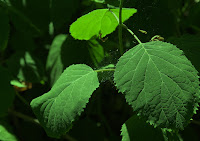Previous blogs set out the process I followed to reach this point. Essentially I tried to establish what colours were actually within the wheel in the Course material. I think I understand what a person means when they say 'red' or any of the other primary and secondary colours. However experience has taught me that whilst I am generally in agreement with others this is only true in very broad terms. I am not colour blind but whether a red is more to the orange end or the violet end of the reds is much more open to discussion. Furthermore the light in which the colour is seen affects our perception (the 'red' sweater that looked so good in the Store looks a lot less acceptable in the daylight).
Although we are asked to find scenes or parts of scenes that are dominated by a single one of the primary and secondary colours I found this very difficult. For example I could take a photograph of a green bush, a yellow flower or a violet flower although on first glance they appeared to be the colour stated there was a range of colours within the picture that could be called 'green' for example.
Closer viewing will show that there are a range of greens as one would expect. Similarly with a violet flower or a yellow flower.
I seemed to come across this range of colours with all natural plants. However I did manage to find one example in the natural world of a dominant green that was very close to the desired green.
The middle image is the first exposure and the one above +.5 of a stop. The other is -.5 of a stop. The large leaf to the right of the image in the first exposure gives the closest match to the colour wheel.
For the red I photographed part of a tapestry that is predominantly red:
The middle file is the first exposure with the +.5 being at the top and the -.5 being the bottom image. The area of red to the bottom left corner of the image created by the lowest exposure level is the closest to the colour wheel in the Course material. There are other 'reds' within the picture some of which appear to have more than a hint of orange.
For the yellow images I found that I had to rely upon a man made colour albeit a dye rather than paint (is there a difference?)
The first exposure is shown in the middle with the +.5 at the top and -.5 at the bottom. On balance the exposure taken at -0.5 of a stop gives the closest match to the colour wheel.
The 'blue' image is also a man made colour dye:
The placement of the images is the same as in the two above. In this case the nearest match lies in the exposure +.5 (the bottom image).
I was fortunate to find a green leaf that at normal exposure gave a close match to the green of the colour wheel.
Again the same placement applies. There is very little difference in the three images if one looks at the large leaf on the right of the picture (this leaf is the closest match in all three images).. The closest match in my opinion is that shown in the middle image.
There were plenty of orange flowers but I was unable to find one where the colour was consistent across a the flower. I therefore tried the more obvious approach of photographing the fruit "orange". I came across this bowl of oranges whilst visiting the kitchen of a former stately home:



The blue surround is the bowl in which the fruit was placed. The closest match is in the last image (+.5 of a stop) being the orange in the foreground.
Violet that was a close match to the colour circle was more difficult to find. In the natural world the plants that appeared violet were often more dominantly blue when photographed. In the man made world of colour the best I could come up with was the painted side of a child's toy in a playground.
The last of the three patches offers the best match. I readily acknowledge that this is akin to photographing a paint manufacturers catalogue.
I took a long time over this project, gave it a great deal of thought and took a large number of photographs. So what did I learn? In one sense not a great deal. I was already aware of the vast range of colours and the primaries and their complements, although based on the RGB of photography rather than the painters circle used in this exercise. Looking for the specific colours heightened this awareness and strengthened my knowledge of the effect of ambient light and the impact of different exposure levels.
As always the benefits gained from doing all this work are not likely to be immediately evident in my work.






































